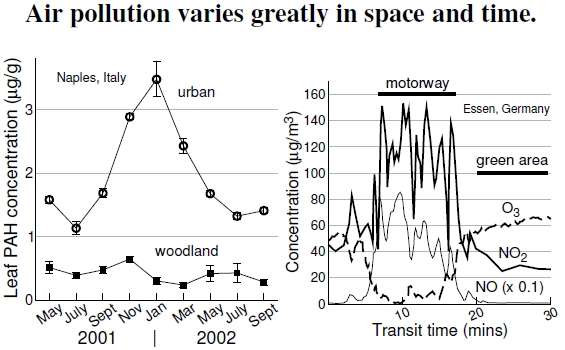4.14 Pollution Variation
Figure 4.14: Tree leaves take up pollutants, including, in the case at left, polycyclic aromatic hydrocarbons (PAHs) in Naples, Italy (after Alfani et al. 2005). These carcinogenic chemicals look like small honeycombs, with each cell being a ring of carbon atoms. At right, a driven transect through the city of Essen, Germany, shows that trees provide better air, or that roadways provide bad air (after Kuttler and Strassburger 1999). Trees in the center of green areas likely absorb less pollution.
As discussed earlier, vegetation can reduce air pollution (see Figure 4.4). This ability arises through a variety of mechanisms, and I show one example of pollution uptake by leaves at left in Figure 4.14. In this case the pollution is a class of carcinogenic chemicals that gets absorbed into leaves’ waxy layers as well as taken in through their open stomata. These studies primarily used leaves to assess pollution levels, rather than examine vegetation as a pollution mitigation strategy.[68]
Suppose a community needed to mitigate air pollution. One way to value trees from this perspective would be to calculate air pollution mitigation costs using something else, calculate pollution reduction by trees, and then determine the value of that reduction.[69] The resulting benefit–cost ratio can be anywhere from 2.2 (the benefit exceeds twice the cost) to -0.8 (trees make things worse).[70] As with any economically viable operation, the benefit–cost ratio must be greater than one (benefits exceed costs) to make trees pay for themselves as pollution control agents. Clearly, trees don’t have magical pollution sequestration powers, as even discarded plastic Christmas trees can sequester pollutants by their very structure. Furthermore, trees living in parks experience lower nitrogen pollution levels, as the right plot shows, because people don’t drive there: Roadside trees are the ones that have real pollution-control jobs.[71]
Of course, pollution control represents just one expected benefit, for example, pollutant-sequestering trees might be part of a small park providing recreational benefits as well as insect-controlling bird habitat. More recent detailed valuations including all of the ecosystem services provided by trees for five U.S. cities found that annual costs per tree ranged from $13 to $65, and the benefits ranged from $31 to $89 per tree, giving benefit-to-cost ratios ranging between 1.4 to 3.1.[72] Directly relevant to the Piedmont region of North Carolina, where Durham sits, one study calculated the costs and benefits of four common tree species: dogwood; Southern magnolia; red maple; and loblolly pine.[73] For small to large trees the average annual benefits ranged from roughly $31 to $112, and the costs from roughly $16 to $27. These numbers make trees seem like a great value.
However, an independent estimate of the utility that tree plantings provide in mitigating atmospheric particulate matter comes from two areas of the U.K. In one area, the West Midlands, the study concluded that quadrupling tree cover from 3.7 to 16.5% would reduce pollution levels by just 10%. Likewise, doubling Glasgow’s tree cover from 3.7 to 8% would reduce PM10 levels by 2%. These reductions are unimpressive, though better than not planting trees, but also implying that emissions control might be the best strategy for pollution control.[74]
—————————–
[68]Alfani et al. (2005) examined polycyclic aromatic hydrocarbon (PAH) uptake in leaves.
[69]One approach for determining the benefit of trees for air pollution reduction assumes the maximum control cost (MCC) guidelines using nonbiogenic sequestration methods. These guidelines specify maximum cost for cost effectiveness through the “Best Available Control Technology” defined by the U.S. EPA. The Bay Area Air Quality Management District’s website, www.baaqmd.gov, has a great deal of information on mitigation issues, and the U.S. EPA New Source Review website, www.epa.gov/nsr, is also informative.
[70]McPherson et al. (1998) present the costs and benefits of trees for reducing air pollution.
[71]In contrast to the actual mechanisms, the graph gives the appearance that green areas might be responsible for high ozone levels. Of course, that’s not correct.
[72]McPherson et al. (2005) and McPherson et al. (2006) examine the values of many ecosystem services provided by trees in several cities.
[73]Botanical names for the common species names: dogwood (Cornus florida), southern magnolia (Magnolia grandiflora), red maple (Acer rubrum), and the loblolly pine (Pinus taeda).
[74]McDonald et al. (2007) used numerical approaches to estimate the value of tree plantings to mitigate atmospheric particulate matter in two areas of the U.K.
